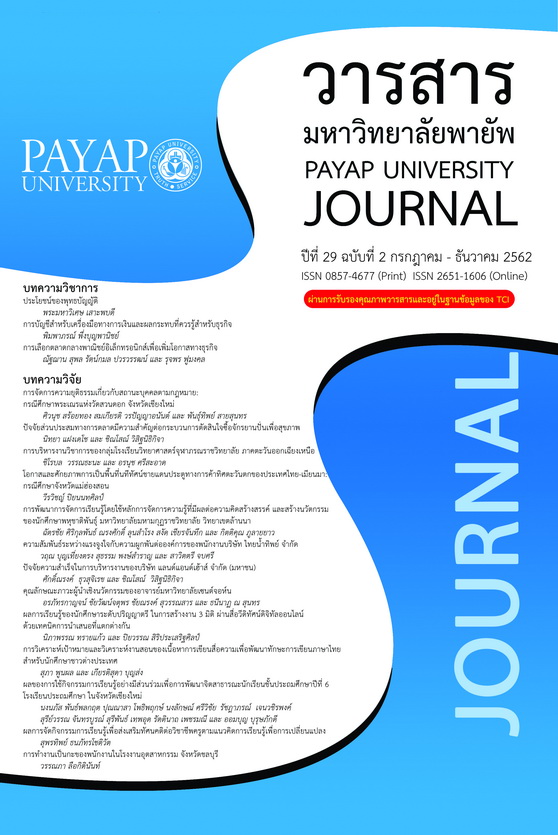Innovative Leadership Traits of Saint John’s University Lecturers
Main Article Content
Abstract
The purposes of this research were to examine the level of innovative leadership traits of Saint John's University lecturers, and suggest the development of innovative leadership traits to Saint John's University lecturers. The population for this study were ninety-one lecturers. The five-point rating scale questionnaire and semi-structured interview were conducted, and all of which were assessed by the three experts. The Index of Item-Objective Congruence (IOC) score was 0.67-1.00. Descriptive statistics was conducted in term of frequency, percentage, mean, standard deviation and content analysis. The findings revealed that the overall level of innovative leadership traits of Saint John's University lecturers was at high level (µ=4.18, σ=0.54), and it was high level when considered in each aspect, the highest was society (µ=4.27, σ=0.57), composed of working as a team, good relationship, ability to communicate and create to all mutual understanding respectively, the lowest was skill (µ=4.11, σ=0.65). There were eight items for suggesting the development of innovative leadership traits to Saint John's University lecturers, the highest item was rated positively workshop in the educational system of innovative management and digital skills.
Article Details
References
ทัศน์ศรี เสมียนเพชร. (2556). การประเมินองค์ประกอบและการพัฒนากระบวนการเรียนรู้เชิงรุกของสถาบันอุดมศึกษาเพื่อเปลี่ยนผ่านเข้าสู่ศตวรรษที่ 21. วารสารสังคมศาสตร์มหาวิทยาลัยวลัยลักษณ์, 6(6), 59-80.
นภัทร บุญเทียม. (2559). การพัฒนารูปแบบภาวะผู้นำของผู้บริหารสถานศึกษา วิทยาลัยในสังกัด สถาบันพระบรมราชชนก ภาคตะวันออกเฉียงเหนือ. วารสารวิจัยมหาวิทยาลัยเวสเทิร์น มนุษยศาสตร์และสังคมศาสตร์, 2(1), 29-38.
นรินทร์ หิรัญสุทธิกุล และกฤษ อังคนาพร. (2559). การปรับยุทธศาสตร์อุดมศึกษาสู่ความเป็นเลิศ (University Reprofile). ใน จุฬาลงกรณ์มหาวิทยาลัย, การปรับยุทธศาสตร์อุดมศึกษาสู่ความเป็นเลิศ, (น.17-37). กรุงเทพฯ: ผู้แต่ง.
นฤนันท์ สุริยมณี และประเสริฐไชย สุขสอาด. (2554). การศึกษาภาวะผู้นำของผู้บริหารหน่วยงาน สังกัดมหาวิทยาลัยมหิดล. วารสารวิทยบริการ, 22(1), 30-40.
พัชรา วาณิชวศิน. (2559). การพัฒนาชุดกิจกรรมพัฒนาสมรรถนะภาวะผู้นำเชิงนวัตกรรมสำหรับนิสิตระดับปริญญาตรี. วารสารครุศาสตร์อุตสาหกรรม, 15(3), 21-28.
พิทักษ์ ทิพย์วารี. (2558). การพัฒนาภาวะผู้นำทางนวัตกรรมสำหรับผู้บริหารสถาบันการพลศึกษา. วารสารบัณฑิตศึกษามหาวิทยาลัยราชภัฏสวนสุนันทา, 8(2), 318-329.
ภิรญา สายศิริสุข. (2561). ภาวะผู้นำเชิงนวัตกรรมของผู้บริหารในโรงเรียนมัธยมศึกษากลุ่มสหวิทยาเขตปัญจภาคี สังกัดสำนักงานเขตพื้นที่การศึกษามัธยมศึกษาเขต 4, สืบค้นเมื่อ 31 สิงหาคม 2562. http://www.banmoh.ac.th/IS/5914651891.pdf.
มนญาวัณย์ เศรษฐพงศ์. (2556). สภาพปัญหาและแนวทางแก้ไขปัญหาในการขอตำแหน่งทางวิชาการของอาจารย์มหาวิทยาลัยเซนต์จอห์น. วารสารวิชาการวารสารเซนต์จอห์น (สาขามนุษยศาสตร์และสังคมศาสตร์), 16 (18), 53-67.
มหาวิทยาลัยแม่โจ้. (2555). โครงการพัฒนาอาจารย์มืออาชีพ: อาจารย์ยุคใหม่ใส่ใจนวัตกรรม ปีการศึกษา 2555-2556, สืบค้นเมื่อ 16 พฤศจิกายน 2561. http://www.mua.go.th. /users/he-commission/t-visit%20project/t- visit%20book%204/2 maejo.pdf.
ศูนย์สารสนเทศอุดมศึกษา สำนักงานคณะกรรมการการอุดมศึกษา. (2560). สถิติอุดมศึกษาเรื่องการรายงานจำนวนบุคลากร ปีการศึกษา 2560, สืบค้นเมื่อ 16 พฤศจิกายน 2561. http://www.info.mua.go.th/information/show_all_statdata_table.php?data_show=4.
________. (2561). ประวัติมหาวิทยาลัยเซนต์จอห์น, สืบค้นเมื่อ 16 พฤศจิกายน 2561. http://www.info.mua.go.th/UProfile /showUnivIntro.php? umas= 060&lang=th.
สันต์ชัย พูลสวัสดิ์. (2557). ความคิดเห็นของคณาจารย์ที่มีต่อภาวะผู้นำของผู้บริหารสถาบันอุดมศึกษาเอกชนส่วนกลาง. วารสารมหาวิทยาลัยนครพนม, 4 (3), 7-14.
สำนักงานการวิจัยแห่งชาติ. (2561). ยุทธศาสตร์การวิจัยและนวัตกรรม 20 ปี (พ.ศ. 2560-2579). สืบค้นเมื่อ 31 สิงหาคม 2562. https://www.nrct.go.th/Portals/0/Document /strategy60-79completecompressed.pdf.
สำนักงานคณะกรรมการพัฒนาเศรษฐกิจและสังคมแห่งชาติ. (2560). แผนพัฒนาเศรษฐกิจและสังคมแห่งชาติ ฉบับที่สิบสอง พ.ศ. 2560 – 2564, สืบค้นเมื่อ 16 พฤศจิกายน 2561. http://waa. inter.nstda.or.th/stks/pub/2017/20170702-National-Economic-Social-Development-Plan-Twelfth-edition.pdf.
สำนักประกันคุณภาพและวิจัย มหาวิทยาลัยเซนต์จอห์น. (2560). ผลการดำเนินงานเรื่องการประกันคุณภาพการศึกษา ประจำปีการศึกษา 2560, สืบค้นเมื่อ 16 พฤศจิกายน 2561. http://www.sju.ac.th/dept_qa.html.
สุเมธ แย้มนุ่น. (2559). การวางแผนเพื่อการเปลี่ยนแปลงของระบบอุดมศึกษาในระยะ 15 ปี. ใน สำนักงานคณะกรรมการการอุดมศึกษา, การวางแผนเพื่อการเปลี่ยนแปลงของระบบอุดมศึกษา, (น.3-9). กรุงเทพฯ: ผู้แต่ง.
โสภิตา สว่างเลิศกุล. (2560). ดิจิทัลสกิล: เตรียมพร้อมสู่ไทยแลนด์โฉมใหม่, สืบค้นเมื่อ 16 พฤศจิกายน 2561. https://www.posttoday.com/life/life/516410.
อรอนงค์ โรจน์วัฒนบูลย์. (2553). การพัฒนาตัวแบบผู้นำเชิงนวัตกรรม. วิทยานิพนธ์ปริญญาดุษฎีบัณฑิต คณะรัฐประศาสนศาสตร์ สถาบันบัณฑิตพัฒนบริหารศาสตร์.
อรุณี หงษ์ศิริวัฒน์. (2561). การอุดมศึกษากับการพัฒนาประเทศ. กรุงเทพฯ: สำนักพิมพ์แห่งจุฬาลงกรณ์มหาวิทยาลัย.
Anand, P. & Saraswati, A.K. (2014). Innovative Leadership: A Paradigm in Modern HR Practices. Global Journal of Finance and Management, 6(6), 497-502.
Best, J.W. (1977). Research in Education (3rd ed.). Englewood Cliffs. New Jersey: Prentice Hall, Inc.
Gumusluoglu, L. & Ilsev, A. (2009). Transformational Leadership and Organizational innovation: The Roles of Internal and External Support for Innovation. Journal of Product Innovation Management, 26(3), 264-277.
Heppner, S. & Wang, T.L. (2015). What are the Measurable Qualities that Define Executive Presence and How can we use these to Tangibly Assess Leaders?, Retrieved November 16, 2018, from https://digitalcommons.ilr.cornell.edu /cgi/viewcontent.cgi?article=1081&context=student.
Hofmeyer, A., Sheingold, B.H., Klopper, H.C. and Warland, J. (2015). Leadership in Learning and Teaching in Higher Education: Perspectives of Academics in Non-Formal Leadership Roles. Warland, Jane Contemporary Issues in Education Research, 8(3), 181-192.
Keengwe, J., Kidd, T. and Kyei-Blankson, L. (2009). Faculty and Technology: Implications for Faculty Training and Technology Leadership. Journal of Science Education and Technology, 18(1), 23–28.
Ricard, L.M., Klijn, E.H., Lewis, J.M., and Ysa, T. (2017). Assessing public leadership styles for innovation: a comparison of Copenhagen, Rotterdam and Barcelona. Public Management Review, 19 (2), 134-156.
Sarna, S.K. (2015). Importance of Leadership for Organizational Excellence, Retrieved November 16, 2018, from http://ispatguru.com/importance-of-leadership-for-organizational-excellence/.
Thiollière, G. & Detouillon, T. (2011). What are the characteristics of leaders when managing innovation in organization? A combination of traits and skills, Retrieved November 16, 2018, from http://www.divaportal.org/smash /get/diva2: 429485/FULLTEXT01.pdf.

